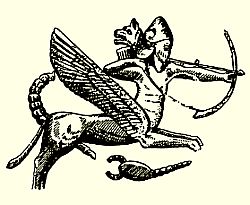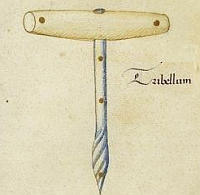Wikipedia
R.H. Allen:
Star Names
Ian Ridpath:
Star Tales
Universe Guide
Sea and Sky:
Constellations
IAU
Map
NASA:
Constellations
|
Wikipedia |
R.H. Allen: Star Names |
Ian Ridpath: Star Tales |
Universe Guide |
Sea and Sky: Constellations |
IAU Map |
NASA: Constellations |


|
|
SagittariusStar Lore |
|


| Sagittarius is a constellation in the northern celestial hemisphere. Its name is Latin for "archer". |


|
|
Ancient Mesopotamia
Figures depicting a centaur armed with bow and arrow on Mesopotamian boundary stones date as far
back as the second millennium BC. In early legends, this figure may not yet have been tied to a constellation, but the depiction of an archer-centaur
overlapping a scorpion matches the position of Sagittarius and
Scorpius in the night sky.
 Pabilsaĝ was a tutelary God of the city of Isin.  Gavin White notes that "... The familiar image of the Greek constellation as a horse-centaur armed with a bow and arrow is, in fact, a simplified version of the Babylonian figure, which is a truly composite character with a number of features not seen in the Greek version, such as a set of wings, a scorpion’s tail and the head of a dog. The details of Pabilsaĝ's iconography show a considerable amount of variation."  Sources: J.H. Rogers: Origins of the ancient constellations, Ian Ridpath, G. White: Babylonian Star Lore |
 Centaur-Archer on Babylonian boundary stone
Source: J. H. Rogers
Centaur-Archer on Babylonian boundary stone
Source: J. H. Rogers
|


|
|
Ancient Greece
The Greeks adopted the Mesopotamian figure of Pabilsaĝ as a centaur-like archer although
the omitted the wings. As there is already a Centaur in the Greek skies (the constellation Centaurus),
there is no particular Greek myth associated with this constellation. Ian Ridpath
describes the confusion:
|

|



|
|
Medieval Europe - Tarabellum
Roughly one half of today's constellation was defined by Ptolemy in the first century. The other half was the
result of the Age of Discovery in the 15th and 16th century.
In the 1,400 years between these two eras, only two new constellations creations were added to the European sky.
|
  Tarabellum in Il Dittamondo, 1355
Souce: atlascoelestis.com
Tarabellum in Il Dittamondo, 1355
Souce: atlascoelestis.com |
Scot describes Tarabellum's location as partially in Sagittarius and partially in Virgo.
 From the 13th to the 16th century, Tarabellum was displayed in European astrological and astronomical manuals as an equal among the constellations of the Zodiac. With the dawn of the Age of Enlightenment and the separation of Astrology and Astronomy, the constellation slowly disappeared.  Source: atlascoelestis.com |



|
|
Ancient India
In Hindu Astronomy, the stars
Kaus Media (δ Sgr) and
Kaus Australis (ε Sgr) are the center of the 20th
Nakashtra, called Purva Ashāḍhā (पूर्वाषाढ़ा), the "first of the aṣāḍhā."
|


|
|
Ancient China
In Chinese, Sagittarius is written
人 馬 座.
|

|
|
A related constellation was Chu, the pestle, to the south of Jī in
Ara, for pounding the rice to remove the husks. Dǒu, the dipper, also known as Nandǒu, (the southern dipper) was formed by μ, λ, φ , σ, τ and ζ Sagittarii, These same stars, bar μ, form the present-day asterism called the Milk Dipper. In a Chinese proverb, the southern dipper marks life while the northern dipper (Beidou, our Big Dipper in Ursa Major) marks death. A single star nearby, probably 5th-magnitude HR 7029, also called HD 172910, was Nóngzhàngrén, an old farmer, perhaps measuring out grain with the dipper and using the winnowing basket. |
 The Hong Kong Space Museum tells the story of the two dippers:  It was said that, in the Period of Three Kingdoms (220-280), there was a famous Taoist priest named Guan Lu. Once day he met a young man named Yan Chao. As an expert in physiognomy, he found the young man would die soon and told the man his ill fortune. At the time, Yan Chao was only nineteen and was really upset by the bad news. He begged the priest to help him. Guan Lu instructed, "You should go home fast and prepare a bottle of good wine and a plate of deer meat. Then go to the south of the wheat fields. Under a giant mulberry tree, you will find two old men playing Go. Serve them well and don't say a word. They may help you."  Following the instruction, Yan Chao finally found the old men as described. He stood beside still and served them with wine and meat silently. Being too concentrated on the game, they enjoyed the feast subconsciously. After some time, the old men to the North suddenly noticed the present of Yan Chao and annoyingly said, "What are you doing here?" Without saying a word, Yan Chao fell on his knees and kowtowed. |
 Two old men
Two old menSource: Hong Kong Space Museum |
| Not knowing how to deal with the young man, the old man finally said, "we've enjoyed his offerings. Let's do something to reward him." The old man to the South said, "Give me your record of death." When he found that Yan Chao was destined to live only nineteen years, he crossed the record out and changed it into ninety. Delighted with unexpected good result, Yan Chao thanked the old men and went home. Afterwards, Guan Lu explained, "the old man sitting to the North is Northern Dipper, the one to the South is Southern Dipper. Southern Dipper is responsible for the birth and Northern Dipper is responsible for the death." |

To the north of Dǒu the arc formed by
υ,
ρ,
43,
π,
ο and
ξ Sagittarii was known as Jiàn, representing a flag or banner, perhaps at a city gate.
(Wikipedia describes Jiàn as "Establishment.")
 Next to Jiàn was Tiānjī, the "celestial cock", formed by 55 and 56 Sagittarii; the bird represented by this constellation was said to be in charge of time, because it was the first to crow at dawn and all others followed it.  South of Tiānjī were two canine-related constellations. Gǒuguó centered around ω Sagittarii is translated as "territory of dogs" or "dog kingdom"; it could represent a nation that appears in a Chinese fable or it may simply be an area for dogs around a farm. Next to it was Gǒu, formed by 52 and χ1 Sagittarii, representing a guard dog.
|
|  The Celestial Cock
The Celestial CockSource: bestiarumvocabulum |


|
|
Torres Strait Islanders / Australia
To the Torres Strait Islanders, Sagittarius was a hunter called Gep.
|
 Suckerfish and turtle
Suckerfish and turtle© Tommy Pau |


|
|
Navajo / North America
Shash, the Bear constellation is considered a spring and summer constellation. It consists of the stars of the Greek constellation
Sagittarius.
|

|


|
Back to Star Lore |
Back to Mythology |
Back to Space Page |
Back to English |
 Back to Start Page |